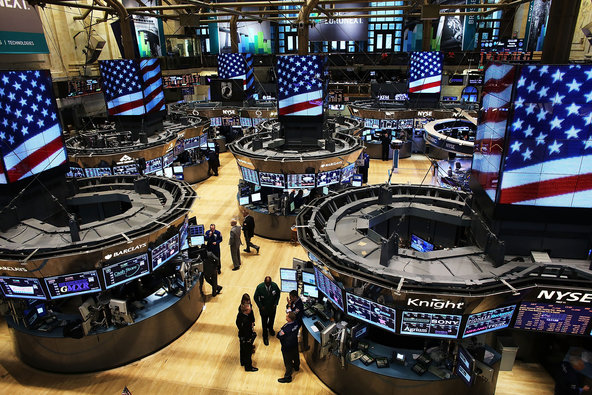It was January 2000, and Mr. Sprecher had been cold-calling Wall Street for weeks. He was searching desperately for someone to back his small company in Atlanta, a business that was eating up his money and years of his life.
That’s when a black limousine pulled up in front of the bar, Jake’s Dilemma. The limo had been sent by the mighty Goldman Sachs to fetch Mr. Sprecher, and as he sank into the back seat that winter day, he set off on an improbable journey that has since taken him to the pinnacle of American finance.
Today Mr. Sprecher, a man virtually unknown outside of financial circles, is poised to buy the New York Stock Exchange. Not one of the 2,300 or so stocks traded on the New York Stock Exchange (combined value of those shares: about $20.1 trillion). No, Jeff Sprecher is buying the entire New York Stock Exchange.
It sounds preposterous. A businessman from Atlanta blows into New York and walks off with the colonnaded high temple of American capitalism. But if all goes according to plan, his $8.2 billion acquisition, announced a few days before Christmas, will close later this year. And with that, 221 years of Wall Street history will come to an end. No more will New York be the master of the New York Stock Exchange. Instead, from its bland headquarters 750 miles from Wall Street, Mr. Sprecher’s young company, IntercontinentalExchange, will run the largest stock exchange in the nation and the world.
Mr. Sprecher, 57, certainly plays the role of a wily upstart. He may wear power suits and a Patek Philippe watch, but he comes across as unusually casual and self-deprecating for a man in his position. He pokes fun at himself for his shortcomings — “I don’t know how to manage people,” he says — and his love of obscure documentaries.
How the New York Stock Exchange fell into Mr. Sprecher’s hands is, at heart, a story of the disruptive power of innovation. ICE, as IntercontinentalExchange is known, did not even exist 13 years ago. It has no cavernous trading floor, no gilded halls, no sweaty brokers braying for money on the financial markets. What it has is technology.
Like many young companies that are upending the old order in business, ICE has used computer power to do things faster and cheaper, if not always better, than people can. Its rapid ascent reflects a new Wall Street where high-speed computers now dominate trading, sometimes with alarming consequences. New, electronic trading systems have greatly reduced the cost of buying and selling stocks, thus saving mutual funds — and, by extension, ordinary investors — countless millions. But they have also helped usher in a period of hair-raising volatility.
Mr. Sprecher (pronounced SPRECK-er) has probably done more than anyone else to dismantle the trading floors of old and replace human brokers with machines. Along the way, he and ICE have traced an arc through some of the defining business stories of our time — from the rise and fall of Enron, to the transformation of old-school investment banks into vast trading operations, to the Wall Street excesses that not long ago helped derail the entire economy. Now, after a series of bold acquisitions, he is about to become the big boss of the Big Board.
Does it really matter who owns the New York Stock Exchange and its parent company, NYSE Euronext? For most people, stock exchanges are probably a bit like plumbing. Most of us don’t think much about them — until something goes wrong. But lately, some things have gone spectacularly wrong.
One sign of trouble came in 2010, when an errant trade ricocheted through computer networks and touched off one of the most harrowing moments in stock market history. The Dow Jones industrial average plunged 900 points in a matter of minutes, and a new phrase entered the lexicon: flash crash.
Since then, flash crashes in individual stocks have been remarkably common, as the centuries-old system of central exchanges has given way to a field of competing electronic systems.
ICE wasn’t involved in any of these problems. In fact, it has been praised as one of the first exchanges to put limits on lightning-quick, high-frequency trading. This points to Mr. Sprecher’s deftness in piloting his company through periods of regulation, deregulation and now re-regulation.
While many banking executives have clashed with Washington, Mr. Sprecher has sensed the changing winds and tacked accordingly. He also stays close — some say too close — to the powerful Wall Street firms that are his customers.
It is perhaps unsurprising that some of the people who make their living on the Big Board’s floor are a bit nervous about the exchange’s new boss. But Mr. Sprecher says they have nothing to fear. His friends and business associates say he could actually turn out to be the best hope for restoring trust in the stock market. After all, he has beaten the odds before.
“There were a number of times when the odds were long, but he wasn’t deterred from stepping in,” says James Newsome, who was Mr. Sprecher’s regulator at the Commodity Futures Trading Commission before becoming his competitor as chief executive of the New York Mercantile Exchange. “A lot of people, if they don’t think they will win, they won’t participate. Jeff doesn’t operate like that.”
For now, Mr. Sprecher is still spending much of his time at ICE’s headquarters in suburban Atlanta. The contrast with the New York Stock Exchange is striking. Behind its neoclassical face, the Big Board is a sprawling labyrinth of historic oil paintings, gilded leather chairs, stained wood and elegant dining rooms — all set amid crowds of gawking tourists.
Article source: http://www.nytimes.com/2013/01/20/business/jeffrey-sprechers-improbable-path-to-buying-the-nyse.html?partner=rss&emc=rss


